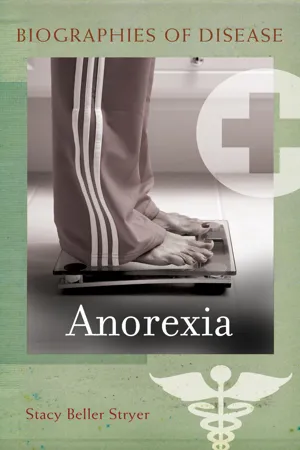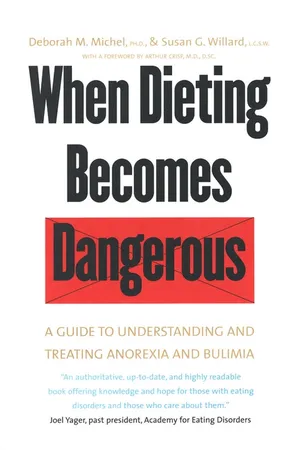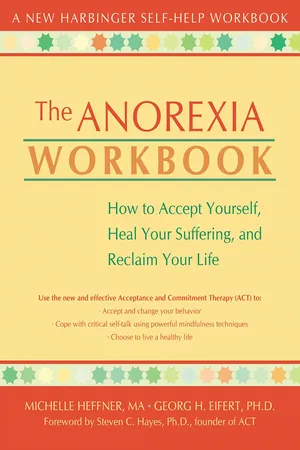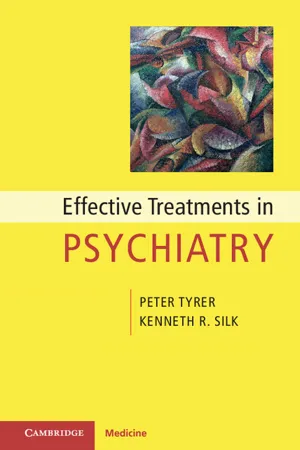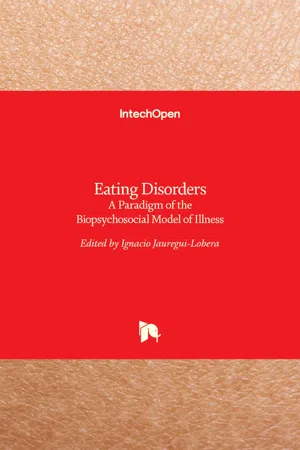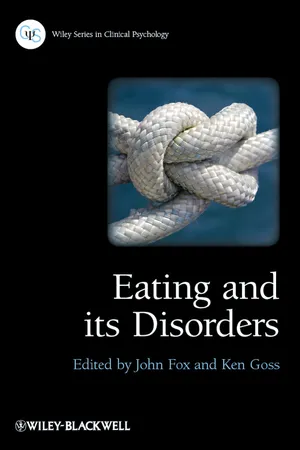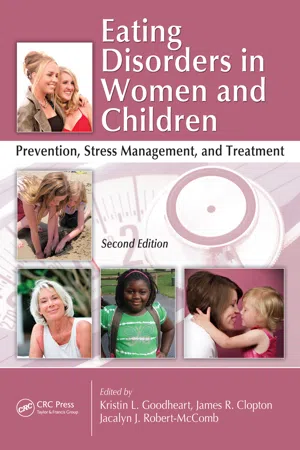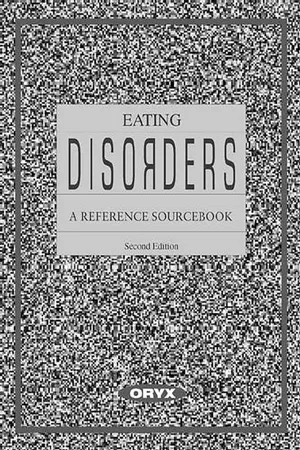Psychology
Anorexia Treatments
Anorexia treatments typically involve a combination of medical, nutritional, and psychological interventions. Medical treatment may focus on addressing any physical complications resulting from the disorder, while nutritional therapy aims to restore healthy eating habits. Psychological interventions, such as cognitive-behavioral therapy, help individuals address underlying emotional and cognitive factors contributing to their eating disorder.
Written by Perlego with AI-assistance
Related key terms
1 of 5
11 Key excerpts on "Anorexia Treatments"
- eBook - PDF
- Hubertus Himmerich(Author)
- 2020(Publication Date)
- IntechOpen(Publisher)
According to the guidelines, treatment for anorexia should involve one or more psychologi-cal therapy, along with additional support including psychoeducation about the illness, monitoring of mental and physical health including weight and risk factors, family/carer involvement and a multidisciplinary team approach from health-care professionals. The recommended psychological interventions differ for adults and children and young people as indicated below [38]. See Table 2 for a brief summary of the psychological therapies for AN in adults and adolescents. 213 Evidence-Based and Novel Psychological Therapies for People with Anorexia Nervosa DOI: http://dx.doi.org/10.5772/intechopen.92680 4.1 Psychotherapies for AN in adults The NICE guidelines recommend four major evidence-based psychological interventions for the treatment of AN in adults. These are: individual eating-disorder-focused cognitive behavioural therapy (CBT-ED), Maudsley Anorexia Nervosa Treatment for Adults (MANTRA), specialist supportive clinical manage-ment (SSCM) and eating-disorder-focused focal psychodynamic therapy (FPT). The guidelines recommend beginning with the first three mentioned therapies and, if found to be unsuitable or ineffective, then considering FPT [38]. 4.1.1 Eating-disorder-focused cognitive behavioural therapy (CBT-ED) CBT-ED is delivered on an individual basis, consisting of 20–40 sessions over 20 weeks, depending on the version used. An enhanced version of CBT is most com-monly used (CBT-E) which originated from CBT for bulimia nervosa (CBT-BN), though as a “transdiagnostic” treatment can be used to treat a broad range of eating disorders including anorexia. - 118 Anorexia COGNITIVE-BEHAVIORAL THERAPY Cognitive-behavioral therapy (CBT) is also a time-limited therapy which has been shown to prevent relapses in some adults with chronic anorexia. Unfortunately, many chronic anorexics who gain weight during this treatment will still eventually lose weight again. As the name indicates, there are two parts to this type of therapy. The first is the educational aspect, where the ther- apist teaches the patient about the characteristics of anorexia. Aaron Beck (1921–), a psychiatrist who developed a cognitive model of therapy in the 1960s and 1970s, believes that emotional disorders are influenced by unpleasant thoughts, and particular behaviors are due to a distorted interpretation of facts. The idea is that an anorexic can be taught to use objective data, such as a scale or book with normal weight for height values to correctly interpret facts. For example, one goal is to differentiate between the thought, ‘‘I am fat;’’ the feel- ing, ‘‘I feel fat;’’ and the reality, ‘‘I am significantly underweight.’’ Beck also believes that patients with emotional disorders develop an all-or-nothing way of thinking about things, such as ‘‘I am fat’’ or ‘‘I am thin.’’ Although Beck mainly used his theories to explain a depressive disorder, other therapists, including David Garner and Kelly Bemis-Vitousek, adapted and applied them to anorexics. They have theorized that those who have anorexia believe that ‘‘thin’’ is good, whereas ‘‘not thin’’ is bad, worthless, and imperfect. Their behavior is to do whatever is possible to become thin and, therefore, good, wor- thy, and perfect. Self-worth becomes defined by body weight and shape. The second aspect of CBT is behavioral. After the therapist and anorexic have discovered the distorted thoughts and beliefs, they then work on the behav- iors which developed as a result of these beliefs.
- eBook - PDF
When Dieting Becomes Dangerous
A Guide to Understanding and Treating Anorexia and Bulimia
- Deborah M. Michel, Susan G. Willard(Authors)
- 2008(Publication Date)
- Yale University Press(Publisher)
five How Is an Eating Disorder Treated? The anorexic patient rarely chooses to go for evaluation or treat- ment. It is usually the parents, spouse, or friends who insist on seeking help. The afflicted individual is typically gratified by her symptoms and they become intrinsically reinforcing. She does not therefore understand why her family and friends are so con- cerned. She generally feels quite successful, in fact, in her quest to be thin above all else. She often denies any problems and re- jects intervention; her resistance makes treatment difficult ini- tially. For those close to the sufferer of anorexia, the disease presents itself as a bottomless pit from which there is no obvious escape. It seems inconceivable that a person who has so much to offer chooses to destroy herself willfully in the face of family and friends, who typically wish to understand and to help. The solution seems so simple—‘‘Just eat’’—yet the problem requires a far more complex solution. The anorexic feels empty inside; her focus on food, weight, and body shape substitutes for any real feeling of self. This lack of personal identity produces frus- tration and fear that is undefined before treatment. The bulimic patient, unlike the anorexic, frequently is re- lieved to have been discovered and to have finally admitted her How Is an Eating Disorder Treated? 51 problem. She tends to be motivated in psychotherapy, anxious to alleviate her symptoms and regain control of her eating. Many patients see their problem as an unfortunate habit that they can- not break and are surprised that psychotherapy is the recom- mended solution. It often takes weeks or months of therapy for the bulimic to realize that underlying conflicts and family issues are the true core of her illness. - eBook - PDF
- Eifert, Georg H., Macera, Michelle Heffner(Authors)
- 2004(Publication Date)
- New Harbinger Publications(Publisher)
We refer to professionals as “therapists.” This is a general term that includes a variety of profession- als, including counselors, social workers, psychologists, students-in-training, and others. Anyone can use the title “therapist,” regardless of their level of training. So, you may want to check their professional title and training before you go and meet with them. Of the many different professionals, psychologists are doctors (Ph.D.s or Psy.D.s) who receive extensive training and have been licensed by the state to treat people with behavioral problems. If at all possible, you should seek treatment from a licensed psy- chologist who specializes in eating disorder treatment. Be aware that not all psycholo- gists are trained to work with eating disorder clients, so you may have to search for the right psychologist. What Are My Treatment Options? The first stop on your road to recovery is to decide which type of treatment you may still need. In this chapter, we’ll help you to make an informed choice, and we’ll prepare you to participate in treatment. Before we tell you more about treatment options, we want to remind you that it may be necessary to contact a hospital emergency room when your life is in danger as a result of your struggle with anorexia. As we discussed in chapter 1, anorexia is the most fatal psychological condition, and you should seek help from a professional immediately if you feel your life is in danger. This is particularly true if you are extremely malnour- ished, or if you are thinking about committing suicide. Professional Treatment Options 143 In-Patient Hospitalization If anorexia threatens your survival, you may need to stay in a medical or psychiatric hospital until your condition improves. You should be hospitalized if you meet any one of the following criteria: ! Your body weight is extremely low, and you are malnourished. ! You are experiencing medical problems, such as heart problems. - eBook - PDF
- Peter Tyrer, Kenneth R. Silk(Authors)
- 2011(Publication Date)
- Cambridge University Press(Publisher)
These have generally shown positive results and it is now suggested that patients with bulimia nervosa should initially be encouraged to follow a self-help programme with one of the evidence-based psychological treatments (National Collaborating Centre for Mental Health, 2004, p. 128). However, a recent random- ized trial (Schmidt et al., 2008) did not provide good evidence of benefit. Summary Cognitive behavioural therapy is the universal first-line treatment of choice for bulimia nervosa and has been endorsed as such. There is no clear second line of treatment, but both interpersonal therapy and behaviour therapy may have some value. Atypical eating disorders and binge eating disorder Atypical eating disorders (or EDNOS) are the most common eating disorder diagnosed in clinical practice (see Fairburn and Bohn, 2005), and epide- miological data support the pre- ponderance of EDNOS among individuals with clinically significant eating disorders (Keel et al., 2004). The absence of research evidence to guide the management of such disor- ders, other than binge eating disorder, means that clinicians are recommend- ed to treat these patients following the principles advocated for treating the eating disorder that their eating Psychological treatments for eating disorders 265 problem most closely resembles. Thus, for conditions resembling ano- rexia nervosa in adolescent patients, a symptom-focused family-based ther- apy may be beneficial. For conditions resembling bulimia nervosa in adult patients, cognitive behavioural ther- apy, behaviour therapy, and interper- sonal therapy may prove useful. A recent study by Fairburn et al. (2009) compared “transdiagnostic” CBT that addressed mood intolerance, clinical perfectionism and low self-esteem with standard CBT and a wait-list con- trol in a group of patients with eating disorders that included all diagnoses apart from anorexia nervosa. - eBook - PDF
Eating Disorders
A Paradigm of the Biopsychosocial Model of Illness
- Ignacio Jauregui-Lobera(Author)
- 2017(Publication Date)
- IntechOpen(Publisher)
Therapists need to approach the adolescent patient with clear expectations and requirements, firmly backed by empathy [17]. 11. Conclusion Current data suggests that eating disorder recovery lies in a complex interplay between weight status, normalization of stress hormones, and global hormonal well‐being for optimal brain function and ongoing brain maturation [17]. Four core principles of effective eating disorder treatment include: (1) changing the neurobiological context, to include nutritional rehabilita‐ tion, weight normalization and stability, without the interruption of compensatory behaviors as symptom substitutions; (2) treating psychiatric comorbidities to remission; (3) addressing external environmental changes; and (4) connecting to maintenance factors for recovery [17]. Unique requirements of the emotionally evolved, flexible, and integrated eating disordered psychotherapist find their roots in one's commitment to a steadfast clarity of intention and purpose throughout an action‐based, goal‐driven treatment dynamic. Setting the facile eating disorder therapist apart from the generalist psychotherapist is his capacity to master, and then transcend, left‐brain technical skills through right‐brain empathic intuition in neurophysio‐ logical connection with the patient's right brain. The practitioner's self‐acceptance precedes his capacity for full acceptance of the ED patient. It takes a special kind of professional to find gratification in a journey that is typically as arduous as it is extensive. It is the “phoenix” of Eating Disorders: A Treatment Apart. The Unique Use of the Therapist's Self in the Treatment of Eating Disorders http://dx.doi.org/10.5772/65697 187 the patient's reemerging unified self that arises “out of the ashes” of a debilitating disease, however, that makes the treatment of eating disorders as gratifying, and at times, as joyful, as it is challenging. - eBook - ePub
- John R. E. Fox, Ken Goss, John R. E. Fox, Ken Goss(Authors)
- 2012(Publication Date)
- Wiley-Blackwell(Publisher)
The aim of this phase is to help parents to stop ineffective responses to anorexic symptoms and block ineffective interactional patterns that might escalate the young person’s emotional expression and behaviour which further impedes the young person’s eating. The therapist instructs parents to minimize ‘anorexic debate’ with the client and avoid fruitless discussion about diet foods, amount to eat and exercise. Parents are encouraged to take control over the adolescent’s eating and they are helped to develop new strategies and skills in managing the disorder and work towards recovery. The ultimate aim of this phase is weight restoration. As previously described, externalization of AN is used and AN is often described as having a ‘voice’. Most young people and their families respond positively to such conversations and find useful the notion that anorexic symptoms are not under the client’s control. Some, however, do not, particularly if they feel that this technique is being imposed or if the young person feels that it may give the parents a licence to take control. In these cases, the therapist discusses with the family the difference between control over eating and control over life and clarifies that empowering parents to take charge over the young person’s eating is justified as the young person’s eating is controlled by AN. It is emphasized that parental control over eating is temporary and the consequence of the illness state, but that the ultimate aim is for the adolescent to regain responsibility over her/his eating when his/her physical state and cognitions improve. The effect of anorexia on the family and the role of anorexia in everyday family interaction are explored and some of the strategies that other families have tried in managing the illness are discussed. Parental beliefs about the impossibility of their effectiveness in helping the young person to eat are challenged and they are encouraged to identify and rediscover their own strengths, resources and resilience, and regain parental authority around eating. The emphasis is on parents finding their own solution for managing the disorder. Observed family dynamics and changes in family organization around the disorder are not perceived as a cause of the disorder, but it is conceptualized that they may have become part of what maintains the problem, even if the changes were initially helpful and functional. The aim of the therapeutic interventions is also to promote mutual empathy among all family members and explore their attitudes towards change, and advantages and disadvantages of change happening. The therapist emphasizes the seriousness of the disorder, acknowledges the parents’ anxiety and concern and encourages them to take a strong stance against anorexic behaviours using their knowledge, resources and skills.Phase 3: Exploring Issues of Individual and Family Development
Once the eating pattern of the anorexic young person has been normalized and is achieving consistent progression toward a healthy weight, anorexic cognitions have lessened and are not controlling the client’s behaviour, the therapist can move the focus of the interventions towards exploring issues of individual and family development. It has been shown that significant numbers of young people who develop AN have issues with generalized anxiety and worry, perfectionism, tolerance of uncertainty and risk taking. Physical development, growing up and discovering adolescent identity may all heighten the fear of uncertainty. Interventions in this phase need to focus on promoting tolerance to uncertainty and reduction of maladaptive perfectionism on individual and family levels conjointly with exploration of issues of independence, growing up, adolescent identity and self-esteem. Where the illness has lasted for some time, these issues are likely to have become exacerbated by the disruption of the expected individual and family developmental process which will have been to a greater or lesser degree replaced by an accommodation to the illness. - eBook - PDF
Eating Disorders in Women and Children
Prevention, Stress Management, and Treatment, Second Edition
- Kristin Goodheart, James R. Clopton, Jacalyn J. Robert-McComb, Kristin Goodheart, James R. Clopton, Jacalyn J. Robert-McComb(Authors)
- 2011(Publication Date)
- CRC Press(Publisher)
Psychiatr News 41: 31. Schlundt, D. G., and W. G. Johnson 1990. Eating disorders: Assessment and treatment. Boston: Allyn and Bacon. Stahl, S. M. 2000. Essential psychopharmacology: Neuroscientific basis and practical applications (2nd ed . ). Cambridge, UK: Cambridge Univ. Press. Sullivan, P. F. 1995. Mortality in anorexia nervosa. Am J Psychiatry 152: 1073–1074. Thase, M. E, and G. S. Sachs. 2000. Bipolar depression: Pharmacotherapy and related therapeutic strategies. Biol Psychiatry 48: 558–572. Tondo, L., and R. J. Baldessarini. 2000. Reduced suicide risk during lithium maintenance treatment. J Clin Psychiatry 61 Suppl 9: 97–104. Walsh, B. T., C. G. Fairburn, D. Mickley, R. Sysko, and M. K. Parides. 2004. Treatment of bulimia nervosa in a primary care setting. Am J Psychiatry 161: 556–561. Wang, T., C. Yuan-Hwa, and I. Shiah. 2006. Combined treatment of olanzapine and mirtazapine in anorexia nervosa associated with major depression. Prog in Neuropsychopharmacol Biol Psychiatry 30: 306–309. Wong, J. C., P. Lewindon, R. Mortimer, and R. Shepherd. 2001. Bone mineral density in adolescent females with recently diagnosed anorexia nervosa. Int J Eat Disord 29: 11–16. Zerbe, K. J. 2008. Integrated treatment of eating disorders: Beyond the body betrayed . New York: Norton. This page intentionally left blank This page intentionally left blank K11180 www.crcpress.com an informa business 6000 Broken Sound Parkway, NW Suite 300, Boca Raton, FL 33487 711 Third Avenue New York, NY 10017 2 Park Square, Milton Park Abingdon, Oxon OX14 4RN, UK Eating Disorders in Women and Children w w w . c r c p r e s s . c o m Prevention, Stress Management, and Treatment | Second Edition NUTRITION Our understanding of eating disorders has impro v ed markedly o v er the past 10 years since the publication of the previous edition of this volume. Early intervention is the key, as body dissatisfaction, obsession with thinness, and restrained and binge eating can be found in those as young as ten. - eBook - PDF
Eating Disorders
A Reference Sourcebook
- Raymond Lemberg, Leigh Cohn(Authors)
- 1998(Publication Date)
- Greenwood(Publisher)
(1986). Bulimia: A systems approach to treatment. New York: Norton. Selvini-Palazzoli, M. (1978). Self-starvation: From individual to family therapy in the treatment of anorexia nervosa. New York: Aronson. Slade, P. (1982). Towards a functional analysis of anorexia nervosa and bulimia nervosa. British Journal of Clinical Psychology 27,167-179. Striegel-Moore, R., Silberstein, L., & Rodin, J. (1986). Toward an understanding of risk factors in bulimia. American Psycholo- gist 41(3), 246-263. Swift, W, Bushnell, M., Hanson, P., & Logemann, T. (1986). Self- concept in adolescent anorexics. Journal of the American Academy of Child Psychiatry 25, 826-835. Weil, A. (1988). Health and healing. Boston: Houghton Mifflin. Nutritional Counseling for Anorexic and Bulimic Patients by Annika Kahm, B.S. Is there a need to educate eating-disordered pa- tients about calories and nutritional balance? Don't most of them know it all? There is a need even if the patients don't agree. Very often their parents, relatives, or friends ask: "Can't you just tell her to eat normally, like everybody else does?" We know, of course, it's not that easy. And patients know it, too. Actu- ally, they often know all about good eating habits; they just cannot follow them. We see this in hos- pitalized patients who achieve weight gains in or- der to get privileges or be discharged. Though they may leave the hospital, they may never learn how to maintain their food intake at healthy levels or understand why this is so important. They will usually repeat the old pattern of restriction and weight loss because it's too scary to gain weight and feel out of control. That's partly why nutritional counseling, with education and motivation, is an important part of the teamwork necessary to help these patients achieve full recovery. The counseling described here is done on an outpatient basis, and most vis- its are weekly. - eBook - ePub
- Carlos M. Grilo(Author)
- 2014(Publication Date)
- Psychology Press(Publisher)
The Maudsley Method or approach to family therapy is guided by the above interactional system model. This family therapy method is a structured, active and collaborative approach. The therapy focuses on the behavioral and cognitive symptoms of AN. The adolescent with AN is viewed as incapable of maintaining an appropriate weight for age and gender and is at risk for becoming incapacitated because of the symptoms and their dangerous consequences. The family therapist provides structure, consistency, and support throughout the course of treatment. The family therapist provides information about AN including what is known about it and possible associated complications and what to expect in the treatment. Typically, the family therapist meets briefly individually with the adolescent AN patient and then holds a longer meeting with the entire family. It is not unusual, especially during the early phases of therapy, for brief focused phone meetings to be held in between meetings to address problems.The first phase of therapy is re-feeding to produce weight gain. The family therapist enlists and attempts to unite the parents and family in developing and agreeing to a consistent approach to eating and re-feeding. This process is facilitated by reviewing and emphasizing with the family's struggles and frustrations in trying to help the child or adolescent. It is frequently necessary to address and dispel parental concerns that they “caused” the eating disorder and it is sometimes necessary to address frustrations that the child or adolescent can simply begin to eat normally if they so desired. The therapist provides support and feedback but it is the parents who develop and carry out the re-feeding. Whenever possible, the therapist enlists siblings to support the AN person.The second phase of therapy begins once steady weight gain occurs and there is both relief and confidence that the family has achieved some progress and re-established some control over the AN. The therapy continues to focus on the behavioral and cognitive features of the AN but the focus broadens and begins to consider other challenges and issues. Frequently, Stressors include social situations (e.g., eating at school, attending parties, etc.) and seemingly basic activities (exercise, sports participation, etc.) that can be major pitfalls if not handled carefully. - eBook - PDF
Psychological Responses to Eating Disorders and Obesity
Recent and Innovative Work
- Julia Buckroyd, Sharon Rother, Julia Buckroyd, Sharon Rother(Authors)
- 2008(Publication Date)
- Wiley-Interscience(Publisher)
D., & Crane, A. M. (2007b). Skills-Based Learning for Caring for a Loved One with an Eating Disorder . London: Routledge. Treasure, J. & Szmukler, G. (1995). Medical complications of chronic anorexia nervosa. In G. Szmukler, C. Dare & J. Treasure (eds), Handbook of Eating Disorders (pp. 197–220). Chichester: John Wiley & Sons, Ltd. Treasure, J., Tchanturia, K. & Schmidt, S. (2005a). Developing a model of the treatment for eating disorder: using neuroscience research to examine the how rather than the what of change. Counselling and Psychotherapy Research , 5 , 187–90. Treasure, J., Whitaker, W., Whitney, J. & Schmidt, U. (2005b). Working with families of adults with anorexia nervosa. Journal of Family Therapy , 27 , 158–70. Wallin, U., Kronovall, P. & Majewski, M-L. (2000). Body awareness therapy in teenage anorexia nervosa: outcome after 2 years. European Eating Disorders Review , 8 , 19–30. 52 PSYCHOLOGICAL RESPONSES TO EATING DISORDERS & OBESITY Whitney, J., Haigh, R., Weinman, J. & Treasure, J. (in press). Caring for people with eating disorders: factors associated with psychological distress and negative caregiving appraisals in carers of people with eating disorders. Whitney, J., Murray, J., Gavan, K., Todd, G., Whitaker, W. & Treasure, J. (2005). Experience of caring for someone with anorexia nervosa: qualitative study. British Journal of Psychiatry , 187 , 444–9. Wykes, T. & Reeder, C. (2005). Cognitive Remediation Therapy for Schizophrenia: Theory and Practice . New York: Routledge. Appendix 2.1 Randomised controlled trials for psychotherapy treatments of anorexia nervosa Pre/Post Baseline BMI/ABW Treatment ‘Good’ RCT N Age (SD) BMI/ABW Intervention effect size completers outcome Halmi et al. (2005) 122 (AN) 24.8 (6.8) 17.8 (1.7) Cognitive behavioural therapy — 43.0% — Fluoxetine — 27.0% — CBT + Fluoxetine — 41.0% — Lock et al.
Index pages curate the most relevant extracts from our library of academic textbooks. They’ve been created using an in-house natural language model (NLM), each adding context and meaning to key research topics.

